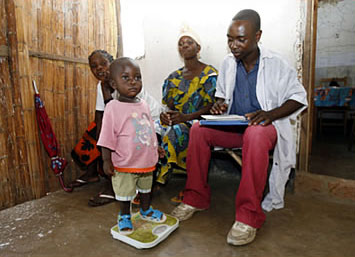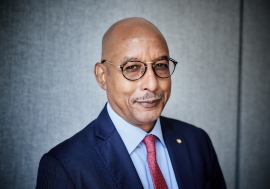Combating Zambia’s ‘hidden hunger’
Combating Zambia’s ‘hidden hunger’
 Checking a child’s weight: Adding vitamins and other nutrients to basic foods can bolster overall health and nutritional standards.
Checking a child’s weight: Adding vitamins and other nutrients to basic foods can bolster overall health and nutritional standards.The majority of children in Zambia eat a meal at least once or twice daily. But despite a full stomach, many lack nutrients essential for their physical and mental development. The Zambian government is fighting this “hidden hunger” by fortifying maize meal, the staple food, with life-saving vitamins and minerals.
“A child can eat three meals per day, but still have problems,” says Mr. Ward Siamusantu, who manages the country’s Maize Meal Fortification Programme. “A few doses short of vitamin A or iron, and you throw away a child’s ability to do their best in life. Impaired children will grow up to be impaired adults, costing Africa billions of dollars in lost productivity.”
African leaders, through the New Partnership for Africa’s Development (NEPAD), are at the forefront of continent-wide efforts to infuse micronutrients — vitamins and minerals — into maize meal, salt, flour, oil, sugar, soy and other foods. One of the goals of NEPAD, the framework guiding Africa’s efforts to accelerate development, is to ensure that all citizens are healthy enough to contribute their full physical and mental potential.
Micronutrient deficiencies debilitate minds and bodies, says a report by the UN Children’s Fund (UNICEF), Vitamin and Mineral Deficiency. The lack of iron alone, the report says, is so widespread in adults that it is lowering overall labour productivity, resulting in estimated losses of up to 2 per cent of GDP in the countries most affected.
“We became concerned when the latest government research revealed that 66 per cent of all Zambian children under five years of age suffer from vitamin A deficiency and 63 per cent lack enough iron,” Mr. Siamusantu told Africa Renewal.
Maize fortification
In response, the government launched a programme in 2006 to fortify all commercially milled maize with iron, vitamin A, folic acid and zinc. Legislation, Mr. Siamusantu says, is also expected by February 2007 to mandate that all maize meal sold in stores contain these essential vitamins and nutrients.
 Fortifying food improves children’s health and their ability to learn.
Fortifying food improves children’s health and their ability to learn.By controlling deficiencies in children, says Amanda Marlin, the communication manager for the foundation Global Alliance for Improved Nutrition (GAIN), African nations can jump-start development in a short period. Set up to foster efforts to fill the micronutrients gap, GAIN is helping fund the project in Zambia.
“Anytime you talk about development, you are talking years of work. But with food fortification, you see results in a short period,” Ms. Marlin says. “NEPAD leaders are supportive of these efforts, because they’ve seen it work in Europe and America and they said, ‘Let’s make this happen in Africa’.”
Several countries in Africa, she says, already have fortification programmes, but GAIN, NEPAD and other partners aim to expand them to 47 countries over three years. It makes sense to tackle the problem on a regional scale, Ms. Marlin continues. Because food is traded between countries, it is important to ensure that food from across the border is all fortified.
“The beauty of this project is that we don’t ask people to change their habits,” she says. “People resist big diet changes. We enhance whatever is already an important part of their diet.”
This was a lesson Zambia had to learn, confirms Mr. Siamusantu, who said the country at first fortified sugar with vitamin A, but found that sugar “was not commonly consumed and we realized it was better to go for the staple food, maize meal.”
The Millers Association of Zambia, which is made up of 33 of the country’s top producers of maize meal, has agreed to add vitamins and minerals to its products. The executive officer of the association, Mr. Harrison Banda, says that at first the manufacturers worried that the additives might affect the quality of the maize meal and therefore hurt business. “We were concerned how the vitamins and minerals would affect the taste, smell and quality of our product. But we have been assured it won’t be a problem.”
Consumers, Mr. Banda adds, had concerns of their own. “Some people worried that this was a ploy by Western governments to experiment on them. They said, ‘Why is this not given to their own people?’ There were rumours that this would cause infertility. Through education campaigns, people now know that even in America and Europe, they eat fortified food. They know it’s good for them and their children.”
‘A noble project’
Millers received machinery from GAIN, but need to purchase the vitamins and minerals out of pocket, raising another public concern that they would pass the costs on to consumers. But that is not the case, Mr. Banda says. “Our production costs will go up by only 3 per cent and this is a small sacrifice given what is at stake. Once our fears concerning quality were allayed, we wanted to be a part of this. We support the reasons behind this project and feel it’s a noble project that should be supported by the private sector.” The association, he says, reaches about 60–70 per cent of the country. The remaining, more remote parts of the country are serviced by small-scale millers.
But across Africa, notes Mr. Steven Lauwerier, a UNICEF programme officer in Côte d’Ivoire, it is in remote rural areas that people are most in need of nutrient boosting. “In towns you have a direct impact, because people rely on commercial food,” he points out. “But these products do not penetrate poor rural areas. There, fortification cannot be used alone. You have to complement it with more community-based nutritional programmes.”
The Zambian millers’ association, Mr. Banda says, is working to bring rural millers on board, if additional funding can be secured. “The vitamin doses needed per tonne of maize meal are very, very small. We cannot allow [the lack of] a few grams of vitamins to set Africa back.”
New Partnership for Africa’s Development
The New Partnership for Africa’s Development (NEPAD) was adopted as the continent’s main development framework at a July 2001 summit meeting of African heads of state. According to NEPAD, attainment of Africa’s long-term development goals is anchored in the determination of African peoples “to extricate themselves and the continent from the malaise of underdevelopment and exclusion in a globalizing world.” It calls for a new relationship between Africa and the international community, in which the non-African partners seek to complement Africa’s own efforts. The United Nations, Group of Eight industrialized nations and various donor countries have pledged to do so.
For Africa to develop, argues NEPAD, three conditions must prevail:
- peace, security, democracy and good political governance
- improved economic and corporate governance
- regional cooperation and integration.
NEPAD further identifies several priority sectors requiring special attention and action:
- physical infrastructure, especially roads, railways and power systems linking neighbouring countries
- information and communications technology
- human development, focusing on health, education and skills development
- agriculture
- promoting the diversification of production and exports.
Many of the required resources will initially need to come from outside the continent, although African governments are redoubling efforts to mobilize more domestic resources. “Africa,” states NEPAD, “recognizes that it holds the key to its own development.”
















